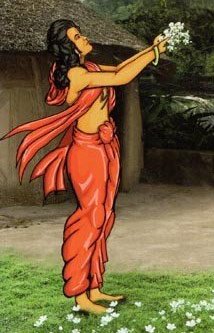Putabhedana, Puṭabhedana, Puta-bhedana: 11 definitions
Introduction:
Putabhedana means something in Hinduism, Sanskrit, Buddhism, Pali, the history of ancient India. If you want to know the exact meaning, history, etymology or English translation of this term then check out the descriptions on this page. Add your comment or reference to a book if you want to contribute to this summary article.
In Hinduism
Kavya (poetry)
Source: OpenEdition books: Vividhatīrthakalpaḥ (Kāvya)Puṭabhedana (पुटभेदन) in Sanskrit refers to “customs clearance center” (litt. where the seals are broken), as is mentioned in the Vividhatīrthakalpa by Jinaprabhasūri (13th century A.D.): an ancient text devoted to various Jaina holy places (tīrthas).—(ZDMG 1985 p. 299-311).

Kavya (काव्य, kavya) refers to Sanskrit poetry, a popular ancient Indian tradition of literature. There have been many Sanskrit poets over the ages, hailing from ancient India and beyond. This topic includes mahakavya, or ‘epic poetry’ and natya, or ‘dramatic poetry’.
India history and geography
Source: archive.org: Personal and geographical names in the Gupta inscriptionsPuṭabhedana (पुटभेदन) is mentioned as a synonym for “town” or “city” according to the Amarakośa 2.2.

The history of India traces the identification of countries, villages, towns and other regions of India, as well as mythology, zoology, royal dynasties, rulers, tribes, local festivities and traditions and regional languages. Ancient India enjoyed religious freedom and encourages the path of Dharma, a concept common to Buddhism, Hinduism, and Jainism.
Languages of India and abroad
Pali-English dictionary
Source: BuddhaSasana: Concise Pali-English Dictionarypuṭabhedana : (nt.) opening of packages.

Pali is the language of the Tipiṭaka, which is the sacred canon of Theravāda Buddhism and contains much of the Buddha’s speech. Closeley related to Sanskrit, both languages are used interchangeably between religions.
Sanskrit dictionary
Source: DDSA: The practical Sanskrit-English dictionaryPuṭabhedana (पुटभेदन).—a town, city; स हस्तिनपुरे रम्ये कुरूणां पुटभेदने (sa hastinapure ramye kurūṇāṃ puṭabhedane) (vasan) Mahābhārata (Bombay) 1.1.12; पुट- भेदनं दनुसुतारिरैक्षत (puṭa- bhedanaṃ danusutāriraikṣata) Śiśupālavadha 13.26.
Derivable forms: puṭabhedanam (पुटभेदनम्).
Puṭabhedana is a Sanskrit compound consisting of the terms puṭa and bhedana (भेदन).
Source: Cologne Digital Sanskrit Dictionaries: Shabda-Sagara Sanskrit-English DictionaryPuṭabhedana (पुटभेदन).—n.
(-naṃ) A city.
Source: Cologne Digital Sanskrit Dictionaries: Benfey Sanskrit-English DictionaryPuṭabhedana (पुटभेदन).—n. a town, Mahābhārata 1, 3978.
Puṭabhedana is a Sanskrit compound consisting of the terms puṭa and bhedana (भेदन).
Source: Cologne Digital Sanskrit Dictionaries: Monier-Williams Sanskrit-English DictionaryPuṭabhedana (पुटभेदन):—[=puṭa-bhedana] [from puṭa > puṭ] n. a town, city, [Mahābhārata]
Source: Cologne Digital Sanskrit Dictionaries: Yates Sanskrit-English DictionaryPuṭabhedana (पुटभेदन):—[puṭa-bhedana] (naṃ) 1. n. A city.
[Sanskrit to German]
Sanskrit, also spelled संस्कृतम् (saṃskṛtam), is an ancient language of India commonly seen as the grandmother of the Indo-European language family (even English!). Closely allied with Prakrit and Pali, Sanskrit is more exhaustive in both grammar and terms and has the most extensive collection of literature in the world, greatly surpassing its sister-languages Greek and Latin.
Kannada-English dictionary
Source: Alar: Kannada-English corpusPuṭabhēdana (ಪುಟಭೇದನ):—[noun] a town or a city.
Kannada is a Dravidian language (as opposed to the Indo-European language family) mainly spoken in the southwestern region of India.
See also (Relevant definitions)
Partial matches: Bhedana, Puta.
Full-text: Patabhedana, Putapetanam, Putabheda, Patabhedaka, Puta.
Relevant text
Search found 4 books and stories containing Putabhedana, Puṭabhedana, Puta-bhedana, Puṭa-bhedana, Puṭabhēdana, Puṭa-bhēdana; (plurals include: Putabhedanas, Puṭabhedanas, bhedanas, Puṭabhēdanas, bhēdanas). You can also click to the full overview containing English textual excerpts. Below are direct links for the most relevant articles:
Amarakoshodghatana of Kshirasvamin (study) (by A. Yamuna Devi)
Town Planning (1): City < [Chapter 3 - Social Aspects]
Vastu-shastra (2): Town Planning (by D. N. Shukla)
Chapter 1b - Origin and Growth of Indian Towns
Towns or Cities in ancient Indian town-planning < [Chapter 2 - Villages, Towns and Forts in General]
The Agni Purana (by N. Gangadharan)
Vinaya Pitaka (3): Khandhaka (by I. B. Horner)
The story of Sunidha and Vassakāra < [6. Medicine (Bhesajja)]